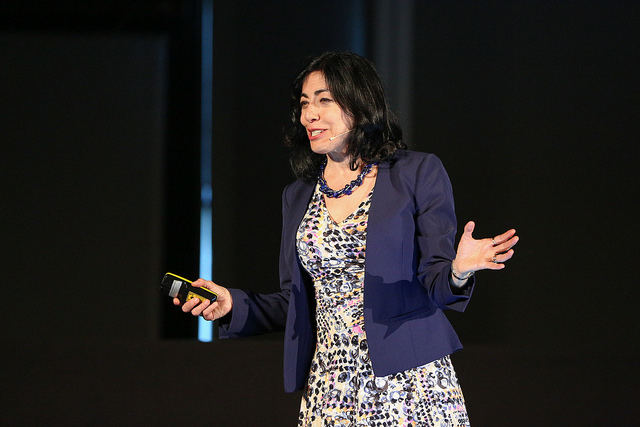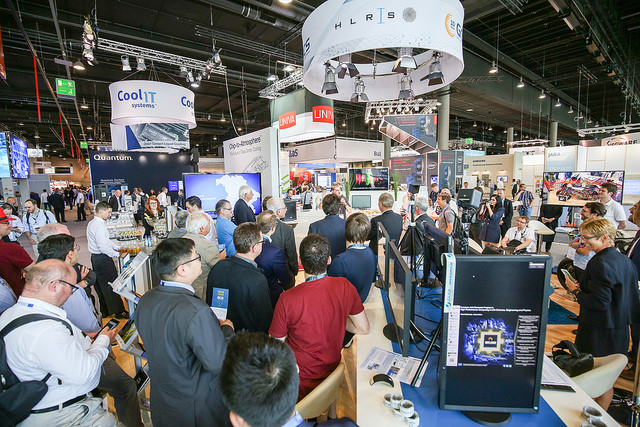HPC Needs of Industry and Institutional Research Highlighted at ISC

Dr. Jennifer Tour Chayes, managing director of Microsoft Research New England and Microsoft Research NYC, presented the opening keynote at ISC 2017. Photo credit: Philip Loeper
Latest News
July 7, 2017
More than 3,250 high-performance computing (HPC) enthusiasts from 60 countries attended ISC 2017, the international supercomputing conference in Frankfurt, Germany, June 18-21. Nearly 150 vendors demonstrated their HPC products—including cloud computing providers, HPC storage solutions, management software, interconnects and more.
 A view of the busy show floor at ISC 2017. Photo credit: Philip Loeper
A view of the busy show floor at ISC 2017. Photo credit: Philip LoeperThe 32-year-old conference is known for targeting academics, government researchers and other institutional users of HPC. With the increased need for more computing power by commercial industries, however, this year ISC featured an Industrial Day, which focused on the future benefits of exascale computing (a quintillion — 1018 — calculations each second) for industrial users, how to purchase HPC infrastructure, and use cases for high performance data analytics (HPDA), such as machine/deep learning, artificial intelligence (AI) and the Internet of Things (IoT).
Many large manufacturers have been using HPC clusters, data centers and cloud computing for years to power large simulations or realistic renderings, for example. With the attention now being given to the amazing possibilities of machine/deep learning and AI for everything from consumer voice-recognition devices to self-driving vehicles to design optimization, even more engineering firms are feeling the constraints of their enterprise computing power.
The Top500 list of the world’s most powerful supercomputers is out, and the US didn’t make the top 3: https://t.co/vmAUTVtnAe #ISChpc
— Digital Engineering (@DEeditor) June 19, 2017
According to the Hyperion Research (the HPC research unit spun off from IDC) presentation at ISC, the worldwide HPC server market reached $11.2 billion in 2016. Industry is making up a growing share of that market. The firm says the mechanical design market spent $57 million on HPC in 2016, while $1.251 billion was spent by the CAE market. That still pales in comparison to the $2.059 billion spent by government labs and the $1.934 billion spent by academia, however.
Hyperion’s Steve Conway on the convergence of modeling, simulation & advanced analytics. Read more here: https://t.co/QPqeHH0gKa #ISChpc pic.twitter.com/CvHWQ5NirT
— Digital Engineering (@DEeditor) June 19, 2017
Is a New CFD Solver Needed for Future HPC?
While some may question whether industry needs the fastest computing available today, there were numerous examples of how commercial applications could benefit from HPC, especially as machine learning and virtual twins become more commonly used. One example came from Dr. Norbert Kroll of the German Aerospace Center (DLR), Institute of Aerodynamics and Flow Technology, in his keynote titled “High Performance Computational Fluid Dynamics for Future Aircraft Design.” Kroll described the DLR as “the German NASA,” explaining that they are developing a next-generation computational fluid dynamics (CFD) software code, known as Flucs, to provide the basis for a consolidated flow solver that is compatible with future exascale HPC capabilities.
The impetus behind Flucs are goals set out by the Advisory Council for Aeronautics Research in Europe (ACARE) in the“European Aeronautics: A vision for 2020” and “Flightpath 2050 — Europe’s Vision for Aviation” reports that require a “radical leap” in aerospace engineering to meet emission and safety goals, according to Kroll.
“These ambitious goals can only be met when we have new product performance, new design principles ... and of course we have to look at unconventional designs,” Kroll said. “The thing is, from the research point of view, today’s products are highly mature. Are improvements possible at all?”
To move forward will rely on being able to create a virtual aircraft that “enables, for all configurations, accurate analysis of all technologies, in all disciplines,” Kroll said, which could lead to certification by analysis. That’s a big task, but Kroll sees numerical simulation and future computing performance as key enablers.
 According to ISC, there were almost as many attendees identifying themselves as being from “Industry” as from “Academia.”
According to ISC, there were almost as many attendees identifying themselves as being from “Industry” as from “Academia.”“The virtual product is really pushing us to improve numerical simulations ... in order to have a high fidelity representation of all important qualities driving aircraft design, driving aircraft testing and up to simulation-based certification,” Kroll said.
Of course, commercial simulation and analysis software providers continually work to improve their code to scale on today and tomorrow’s computing platforms. Kroll admitted they have a number of advantages, but “our big advantage ... is that we can hopefully provide for the particular application of aeronautics solutions for CFD.”
Design and simulation complexity continues to grow, not just in aerospace, but in many other industries looking to benefit from the use of digital twins, learn from the data their connected products are collecting, and train their products to be smarter. As this year’s ISC showed, industry is increasingly turning to HPC for help with that growing complexity.
For an overview of ISC 2017, check out the video below.
Subscribe to our FREE magazine, FREE email newsletters or both!
Latest News
About the Author
Jamie Gooch is the former editorial director of Digital Engineering.
Follow DE





